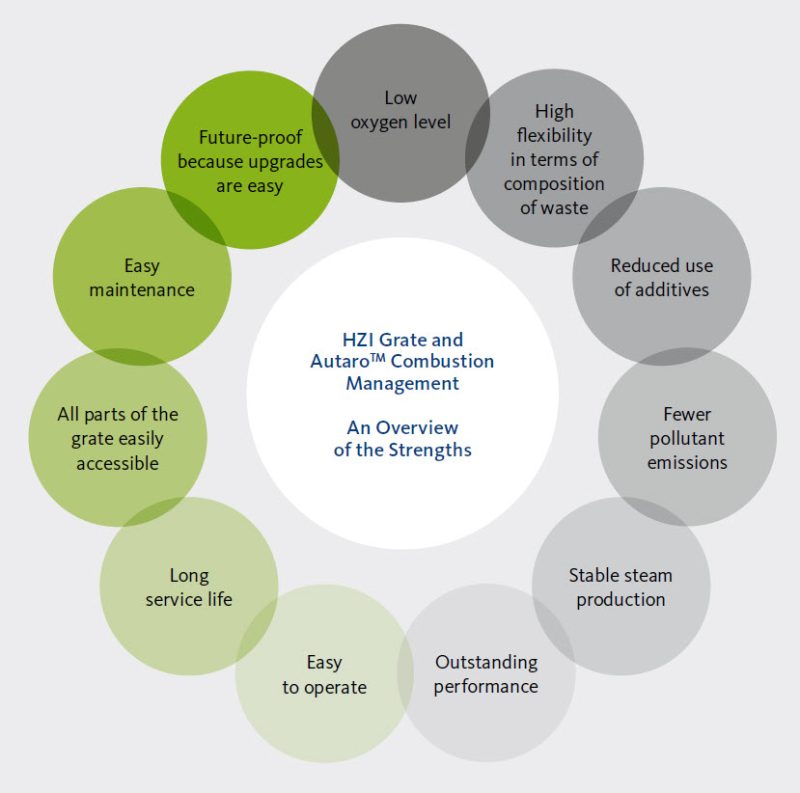Kanadevia Inova Grate and Autaro™ Combustion Management
Kanadevia Inova Grate and Autaro™ Combustion Management
The Ideal Combination for Your Waste to Energy Plant
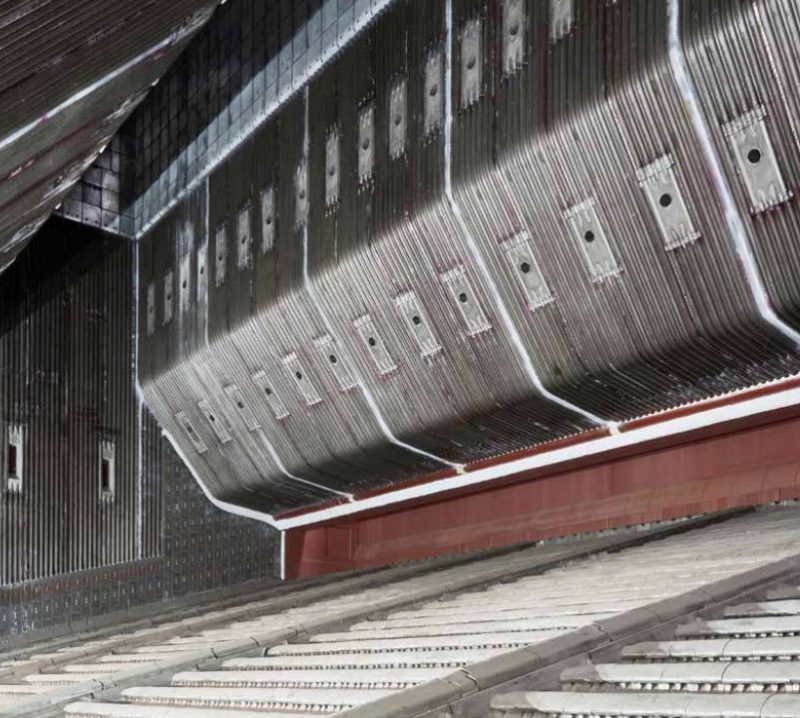
The Muscle and Brain of Your Waste to Energy Plant
Waste to Energy plants treat waste thermally to generate environmentally friendly energy.
To maximise cost-effectiveness and efficiency, the incineration system must satisfy the most
demanding requirements.
A good incineration system consists of a good grate and a good management unit. Kanadevia Inova now offers its new Kanadevia Inova grate in combination with the AutaroTM combustion management platform for the ideal interplay of hardware and software: the muscles and brains of your plant. It’s a combination that ticks all the boxes if you’re looking for a modern and efficient incineration system for your Waste to Energy plant.
Drawing on our decades-long experience and wastespecific know-how, we’ve now set new standards for the incineration technology used in Waste to Energy plants, giving you greater flexibility in dealing with different compositions of waste and greater steam stability, all at surprisingly low levels of oxygen.
Next Generation: Kanadevia Inova Has Rethought the Grate
The new Kanadevia Inova grate is based on the successful Kanadevia Inova technology used in earlier models but has been improved significantly again thanks to intense development work. All the elements are now wider and the zone length has been optimised. At the same time, the number of parts has been reduced by 25%.
More Economically Efficient Thanks to Optimised Design and Significantly Easier Maintenance
One improvement has been to the substructure of the grate, which has been made more open to allow easier access and maintenance. All the grate blocks, including those that are water cooled, can also be swapped out individually without having to remove other blocks.
The coordinated overlapping of the grate blocks also ensures optimum utilisation of the casting material and minimises wear. The front edge of the grate block has also been reinforced against wear. This will extend the life of the equipment and prevent the air holes from becoming blocked.
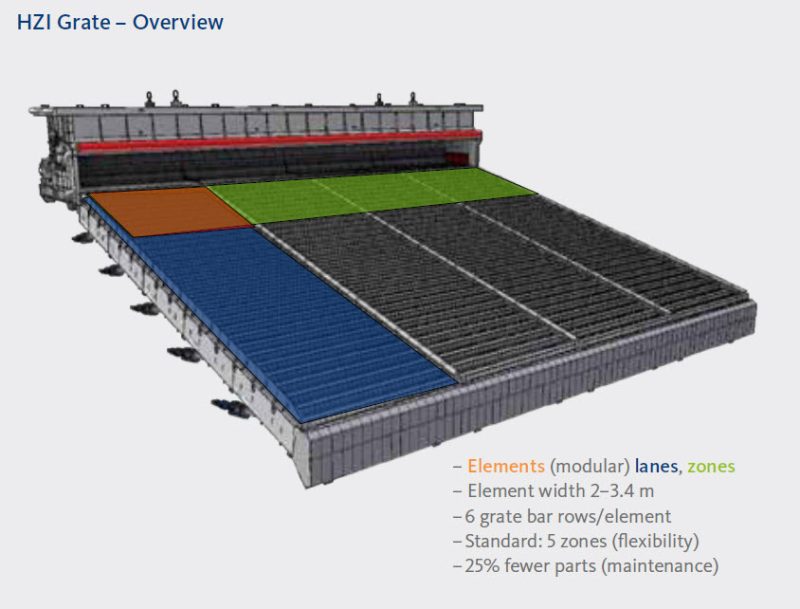
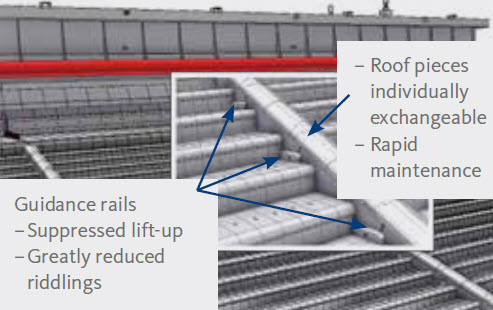
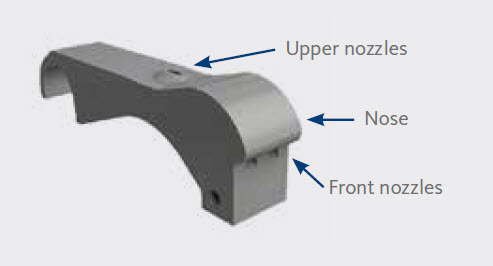
The rollers on which the carriage moves are now even longer-lasting and feature a hood for protection from deposits of ash and molten aluminium. The roof elements can also be replaced individually. Special guidance rails prevent parasitic air from entering. The new contactless grate sensor represents an additional optimisation. It is maintenance-free, has a very long service life and can be replaced in less than a minute. The result of all these improvements is significantly shorter maintenance times and noticeably less material usage.
Decisively More Space for Maintenance Work
Access to the grate hydraulics and the grate hopper has also undergone a significant improvement, with additional space and stairs to the ash transport systems facilitating regular maintenance work, as does access through doors without stairs. The fact that each element of the grate can be controlled directly also simplifies work.
Now Even More Stable and Reliable in Operation
Fuels are conveyed into the combustion chamber via the feed hopper. The ram feeder and its sloping rear wall ensure that the fuel is pressed evenly and thus distributed homogeneously on the grate. All important systems in the process have been made more compact and can be controlled individually. All these optimisations create more space and allow easy access for maintenance work.
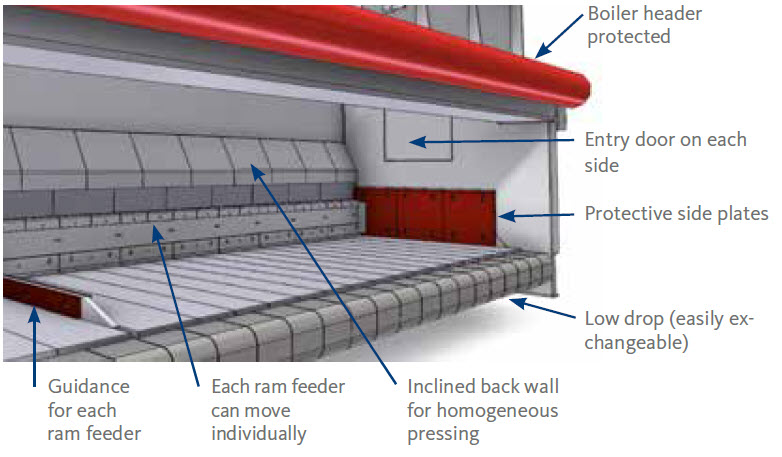
AutaroTM by Kanadevia Inova: A Combustion Management System That Doesn’t Only Produce Steam on a Stable Basis
The main job of a combustion control system is to ensure even plant operation and the constant production of steam.
Another key factor is flexibility. Fluctuations in waste compositions and calorific values at different plants require correspondingly flexible processes – and thus the right control system. This is also important if the waste does not burn as desired. In such a case it must be dried and moved and oxygen must be fed in additionally.
Optimum Combustion with Little Oxygen
With AutaroTM the plant can operate with significantly lower oxygen levels than usual and keep the oxygen content downstream of the boiler below 4% – an impressively low value. With combustion optimised by the adaptive reduction
of oxygen, a reduction of NOx is also achieved without exceeding CO limits. This in turn leads to a reduction in the use of DeNOx additives. If less air is blown in, less fly ash and exhaust gases are produced. This means new plants can be designed
with smaller flue gas systems. There are also considerable savings in energy consumption and a lower overall environmental impact, which makes the plant particularly sustainable. In retrofits, new reserves can be created by operating at a low oxygen
level, meaning that higher loads can also be achieved.
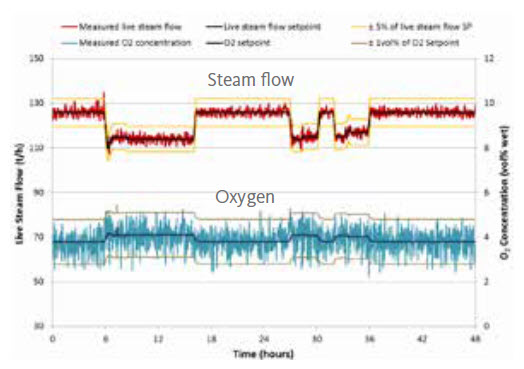
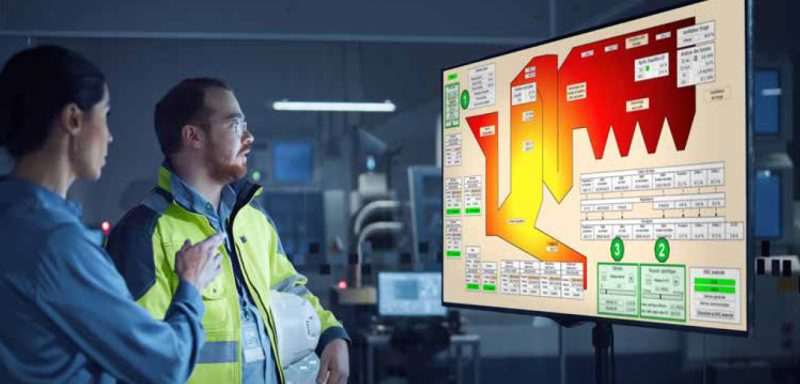
1. Steam flow
setpoint: Desired load of
the plant
2. Waste net calorific value (NCV): Automated but manually adjustable; Sets basic values for all actuators
(ram feeder/grate speeds, air temperature and distribution, etc.)
3. Material adjustment: Automated but manually adjustable; Sets ram feeder and grate speed to get desired waste distribution and fire end position
4. Manual adjustment of actuators still possible: For start-up, shut-down, tests, maintenance, etc.
A User Interface That Leaves the Operator Room for Manoeuvre
The AutaroTM user interface is also impressive. AutaroTM controls the entire process independently, but offers the operator numerous options for intervening at any time. This applies, for example, to the lower calorific value (net calorific value): The operator specifies a value. The algorithm then calculates an adjusted value in an interval around the estimated value from exhaust gas data, taking weather data into account. This forms a basis for specifying air settings.
The Brain Uses its Muscles
The entire combustion process is monitored with various sensors and cameras. Sorting quantity control involves permanently tracking and controlling the condition and behaviour of the material in the feed hopper via a camera. At the same time, the density of the material is calculated in order to adjust combustion to it and to guarantee optimum burnout.
If bulky or poorly composed waste blocks the feed hopper, this is detected by the system and it starts to unblock it with the help of the flaps. If this does not work, the operator can intervene. This prevents damage to the system, a reduction in steam production or downtime. The operator is able to influence the burnout and the position of the fire with the ram feeder (number 3). This enables as much energy as possible to be generated and the amount of bottom ash to be minimised. The process is optimised accordingly by adjusting the movement of the grate and the air distribution. This results in a uniform layer of bottom ash, significantly extending the service life of the grate.
AutaroTM Is a Plus for Any Plant
The AutaroTM combustion control platform is not only available in combination with the new Kanadevia Inova grate. Existing plants or even plants from other manufacturers can also be retrofitted with AutaroTM from Kanadevia Inova, significantly improving all processes.
Fit for the Future
In combination with the AutaroTM combustion control platform, the Kanadevia Inova grate forms a powerful, effective and future-proof incineration system that can be flexibly adapted to different conditions.
